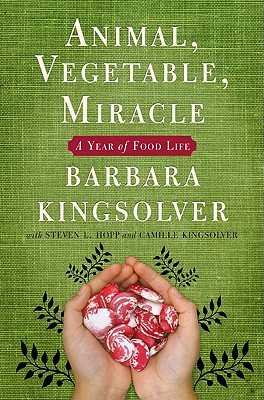So, this new book I’m gobbling up has me thinking a lot about the locality, seasonal freshness and nutrition, and carbon footprint of the food we eat here at the Lazy W.

Before I go any further, let me state firmly that we Lazies are unlikely to undergo any kind of food revolution or take up any new environmental banner worth flying. I mean, not exactly. All I’m trying to do is raise our global agricultural and economic awareness a few notches and improve the health of our bodies and our soil as we go. Noble enough for this house. Plus, there’s the small matter of pursuing a private edible Eden like this one…

This morning I took my notebook into the kitchen and made a quick inventory of everything we had stocked between the freezer, refrigerator, pantry, and fruit bowls. I also tried to write down as many of the things we buy throughout the year that happen to not be around right now. This list was staggering. We are just two people, you guys, and the volume and variety of foods we keep near us seems gluttonous when viewed as a whole. I mean, really. Beyond that, I was more than a little shocked to see how much processed junk still lingers within our walls even after so many attempts to clean up our diet. But the point of this exercise is not chastisement and guilt trips but rather growth and improvement, so onward we go!
The next step of the exercise inspired by Barbara Kingsolver was to examine which of our food stuffs is or could be produced more or less locally. I skipped the “is” question because deep in the recesses of my cheap skate shopping mind I already knew the answer. Let’s just say that I gravitate toward off brand labels. Lots of bright yellow boxes in my pantry, folks, and I am not really ashamed of that.
But the “could be produced locally” question was exciting. This was yet another time when being a native Oklahoman filled me with pride and gratitude. My home state is rich with agricultural bounty, so even those items which I myself have not grown or produced, I felt sure I could find them (or most of them) in some way nearby.
I sat down with a cup of hot coffee and, trying to ignore the guinea fowl chirping noisily at the window, began marking which of the 115 items* on my list could be moved from the shopping list to the production plan. It was as much fun as circling items in the seed catalog!
*Note: Many of the 115 items I listed are just categories of things we buy.
So many product variations exist in our processed food culture
that I found it counterproductive to list every single thing.
This in itself could serve as a wake up call
to how much money and energy we waste
in pursuit of flavor or convenience or both.
Okay. My specific personal lists and plans may be of little interest to you this early in the morning, but I will say that the list of 115 store bought items was easily whittled down to 51. I found 64 edible items that could be produced here at this hobby farm or sourced right here in Oklahoma! Still more that remains on the list of 51 could be eliminated for the sake of efficiency, but that’s a task for another day.
I definitely encourage you to try this exercise yourself. It is fascinating to realize how many wonderful edibles can be grown, produced, or culled right from your own back yard! Search out other local producers with whom you might do some old fashioned bartering. Visit your farmers’ markets when they’re in season. Find a local orchard. Examine the meat markets.
These are all steps we can take toward healthier diets, more stable growing environments, and economies that are ever so slightly less dependent on fossil fuels. Plus, the pleasure of growing your own food is a known stress reducer, and gardens are proven value boosters for homeowners.
Wow, I have no trouble at all finding a soapbox in the morning! Sheesh.
In Zone 7 we are fast approaching the first of many planting dates, friends, so these are the scheming weeks. This is when we still have time to decide to fully maximize our dirt patches and become contributors rather than just consumers. This is when we drive to our local horse-chicken-and-buffalo-keepers and relieve them of a bucket or two of manure for our compost. (hint-hint)

We have snow on the ground as I write this morning. It is perfectly beautiful, and it is providing some much needed moisture to the pastures. But it also means I won’t be scooping manure or filling raised beds today, which is where my heart kind of sits. Perhaps this will allow some extra time to catch up on other worthy pursuits. All good things are seasonal, after all.
Have a great day, you guys!
Whatever Your Passion, Dream Big!
xoxoxo



